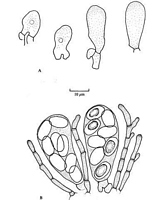|
 Coprotus trichosuri Coprotus trichosuri
BiostatusPresent in region - Exotic
Images (click to enlarge)
Caption: Fig. 1. Coprotus trichosurus. A, Immature asci; B, mature asci, ascospores and paraphyses. |
Article: Bell, A.E.; Kimbrough, J.W. (1973). Coprotus trichosurus sp. nov. from New Zealand. Transactions of the British Mycological Society 61(1): 190-193.
Description: Apothecia sessile, scattered or gregarious, 125-175 µm diam, colourless when fresh, drying to
pale yellow. Apothecial wall composed of globose cells which may become angular through
mutual pressure. Asci broadly clavate (Fig. 1 A, B) approximately 50-60 x 20 µm when
mature, with little or no stalk, containing eight biseriately arranged ascospores. Ascospores
bluntly oval, 9-14 x 5-6 µm (Fig. 2), smooth-walled, hyaline, sometimes containing a
refractive bubble (Fig. 1 B). Paraphyses hyaline, cylindrical, septate, sometimes with short
branches, 3-4 µm in diam and similar in length to the mature asci.
Notes: Coprotus trichosurus appears most closely related to C. granuliformis (Cr. & Cr.) Kimbrough
and C. breviascus (Vel.) Kimbrough, Luck-Allen & Cain. All three species have very short,
broad asci (45-60 x 15-30 µm), and ascospores that approach 15 µm in length. Coprotus
trichosurus may be distinguished from these species, however, in that its apothecia are
usually -smaller and devoid of pigments, its spores are from 1.0-5.0 µm smaller in diameter,
and its paraphyses are neither broadly inflated nor filled with lipid bound pigments. Although
certain collections of C. granuliformis appear colourless, small lipid droplets may still be
found in the paraphyses. The paraphyses in C. breviascus are slightly uncinate and filled with
large pigmented droplets, while those of C. trichosurus are straight, cylindric and devoid of
pigmented droplets.
|